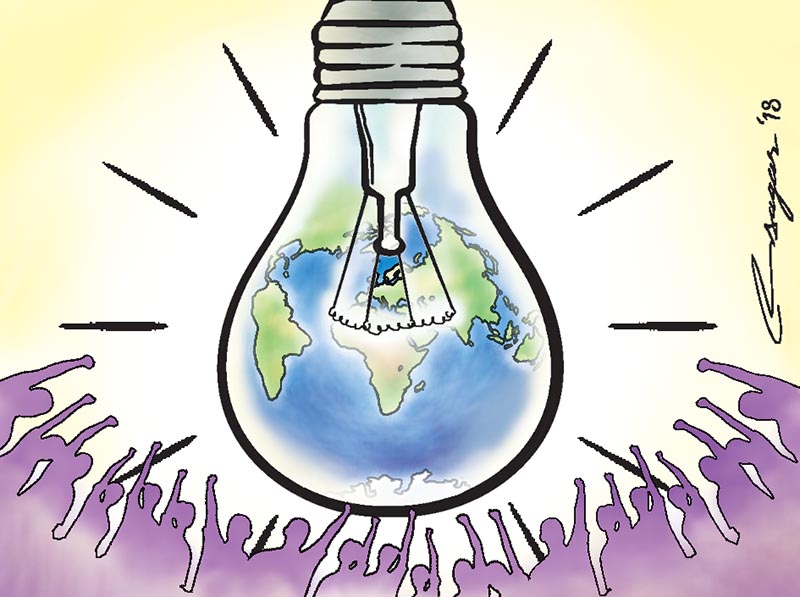Universal electricity access: Why should we wait until 2030?
In coming years, there will be surplus of electricity, at least in the wet season, in the NEA system. If the power utility makes a push, even a slight one, electricity access target can be achieved in Nepal much earlier than 2030
According to the National Planning Commission, in 2015 74 per cent of the country’s population had access to electricity. The recently published economic survey of the Ministry of Finance, however, shows 69.9 per cent in rural areas and 95.7 per cent of people in urban areas have access to electricity. It means if we base on the given information, there are still at least around 25 to 30 per cent people out of the reach of electricity, mostly in the rural areas.
Access to grid electricity is limited and is largely confined to accessible areas.
According to the Nepal Electricity Authority, the figure for domestic connection has reached 3,060,955, which is referred to as 56 per cent of the total population connection. In addition, 18 per cent population is said to be electrified from renewable energy sources. The renewable energy sources mostly comprise mini/ micro-hydropower and solar/ wind systems. Around 30MW of mini/micro-hydropower and 26.5MW of solar/wind systems have been installed so far.
The electricity access information – whether it is 74 per cent or 70 per cent – however is doubtful.
Use of renewable energy is largely confined to the community or individual level. It is not known exactly how many systems are really in operation. The numbers counted for the micro/ mini-hydropower correspond to the total installation capacity; counted from as early as 1996 or even before. Some of these plants might have already been abandoned, or dismantled or damaged.
Subsequently, these plants were never put back into operation again. Some of the areas previously served by the micro-hydropower may have already been connected to the national grid. In this case, it may then result in double counting for the both grid supplied connections and the connections counted for the renewables. Further, lifetime of some of the micro/mini-hydropower plants is already completed requiring complete refurbishment or replacement.
Similarly, there are chances of double counting on the use of solar home systems. Because many houses – which are supplied by the grid – are also using solar energy as the back-up source. Furthermore, energy supplied by the solar systems has limited usages – lighting up a few bulbs for a few hours in the morning and the evening, charging mobile phones and operating television sets, mainly the black and white ones.
If we consider these facts, the real number for energy access may come down drastically. Then it seems that effective electrification rate can be much lower than the figures reported in the national documents.
The effective electrification rate, then, can be at around 60-65 per cent in Nepal, which needs to be ascertained.
The sustainable development goals target relating to electricity access is to secure 99 per cent by 2030. According to the Central Bureau of Statistics (CBS), there will be around 33.33 million people in 2030 based on the medium variant population growth rate scenario. Then the electricity access needs to be extended to cover an additional 13.10 million to 14.53 million people by 2030. The populations to be covered in the future electrification programme will mostly be in the rural areas because – according to the CBS projection – still around 70 per cent population will be residing in rural areas in 2030.
A total of 1.23 million people got electricity access in the last 10 years. Of them, two third of the population got access from the grid line extension and remaining one third from the off-grid solutions such as micro-hydropower and solar home systems.
The last 10 years were not favourable to the NEA to increase electricity access because of deficit in its supply.
The present electricity assess is, however, not uniformly distributed across the country. There are also disparities in terms of electricity access in seven provinces in Nepal.
There is no access of grid electricity in 11 municipalities and 103 village municipalities. The electricity access programme should focus on extending the national grid to the extent it is feasible.
The mini-grid based on mini/micro-hydropower, solar and wind or hybrid can be the next priority options because Nepal has ample resources for the renewables.
Stand-alone solar system should then be the last priority only, which cannot be supplied cost-effectively by the grid extension or the mini-grids. There are many scattered settlements in the country with a few households, where solar energy can become a cost-effective solution. Solar energy can better be seen as back-up or supplementary energy sources across the country to strengthen the sustainable electricity access.
In coming years, there will be surplus of electricity, at least in the wet season, in the NEA system.
If the power utility makes a push, even a slight one, electricity access target can be achieved in Nepal much earlier than 2030. With the popularity of solar energy and other mini-grid options, the areas which cannot be cost-effectively served by the grid can be connected easily through the mini-grids and solar systems. Therefore, the government can easily plan to achieve electricity access targets in the next five years at the maximum.
Adhikari is an energy economist






